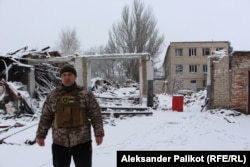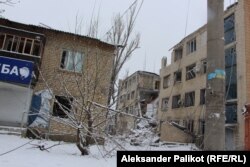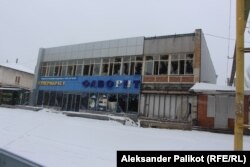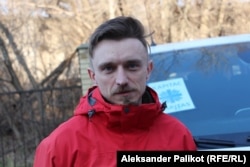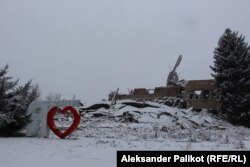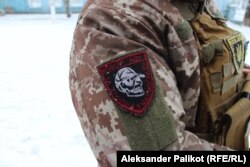HULYAYPOLE, Ukraine -- "From the patriotic standpoint, we are not afraid, of course," said Serhiy Yarmak, the mayor of this town on the southern Ukrainian steppe, standing in front of what remains of the city council garage -- a pile of rubble covered with fresh snow.
The brick building was destroyed in a missile strike that killed his deputy and a local utility company director in October.
"But, of course, in reality, everybody is worried that soon we might become another Bakhmut," he added, referring to a city in the eastern Donbas region where Ukrainian forces have held out for months against a relentless Russian onslaught in some of the fiercest fighting in Russia’s war on Ukraine.
As Ukraine braces for a renewed offensive in the Donbas -- which may have already begun -- the southern front remains relatively stable, despite daily barrages of artillery fire and an intense Russian bombardment of energy infrastructure in the city of Zaporizhzhya on February 10.
The flat stretch of land between Ukrainian-held Zaporizhzhya and Russian-occupied Melitopol, near the Azov Sea coast, holds strategic value to both sides as a key to control of access to the Crimean Peninsula, which Russia seized in 2014.
With their fate to be determined and even the next few days and weeks uncertain, the residents of Hulyaypole -- a town known as the birthplace of Nestor Makhno, an anarchist revolutionary who played an important role in the Ukrainian Civil War of 1917-21 -- struggle to get by as mortal danger looms daily and living conditions deteriorate.
Killing Time
In the first days of the full-scale invasion that began last February, Russian troops briefly entered Hulyaypole, but they were quickly pushed back by the Ukrainian side. Since then, with the front line at its outskirts, the town has been under almost constant shelling -- and residents say it’s gotten worse since December.
Over the ensuing year, Russian rockets and shells from mortars and howitzers have destroyed the local administration office, the town’s large sports and cultural complex, a children's library, a kindergarten, a church, and other buildings. Only a handful of modest houses and low-rise Soviet-era apartment blocks remain untouched.
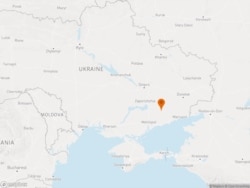
According to the local authorities, more than 30 people have been killed and at least 40 wounded in the attacks.
Yarmak -- who received a state award for courage from President Volodymyr Zelenskiy in the summer -- is staying in the town, asserting that "without the authorities in place, everything would collapse."
Police keep looters in check and enforce a local alcohol prohibition; municipal employees repair some of the destroyed buildings and clear away garbage; the local hospital continues to operate; and evacuation to safer parts of Ukraine is available every day, he told RFE/RL last week.
But with no heating, electricity, or running water since March, the living conditions in Hulyaypole are dire.
Fewer than 3,000 of the 13,000 people who lived in Hulyaypole before the invasion have stayed. Almost all of them live in basements.
"This silence makes me afraid.… What will come after it?" Avhustyna Psevdaklyayeva, 67, said earlier this month as she emerged from a cellar where she lives with six other people.
There had been no shelling since the previous afternoon, she told RFE/RL, which was "as unusual as it is unnerving."
With broken windows and walls that tremble when shells are falling, the apartment where she had lived before the war is cold and wet and "too scary to live in," she said, explaining why she prefers to stay underground.
Her children and grandchildren left for Zaporizhzhya, the region’s capital 100 kilometers to the northwest, but she decided not to join them, citing a lack of money as one of the reasons.
Psevdaklyayeva's husband died two weeks earlier of a heart attack. She would be "completely alone," she said, if not for the people she shares the cellar with.
"The volunteers provide us with food. We have a stove and wood. It's much better to live here than die above ground,” said Lyudmyla Zhovnyrenko, 52, who lives with Psevdalyayeva.
"Our boys are defending our town very well, so we are not losing hope," she added.
With the sound of artillery in the background, the women and their neighbors tirelessly repeat their routines. Every day they get up, drink tea, fire up their stove, wash, and prepare hot food.
In the evenings, they gather around the table beneath the Ukrainian flag and Orthodox Christian icons.
"We reminisce about better times," Psevdaklyayeva said. "It's easier to kill time this together."
According to Serhiy Zvilinskiy, 34, a local historian and Hulyaypole native who coordinates humanitarian aid at Caritas Zaporizhzhya, most of the people who left the frontline town hope to come back if a Ukrainian counteroffensive pushes the Russians farther away.
Before Russia's full-scale invasion, Zvilinskiy had been devoted to preserving the heritage of the town that was once the capital of Makhno's "anarchist republic." Now he is documenting the destruction wrought upon it by the Russian Army.
“The scale of the devastation will make a return to normal life difficult and the costs of reconstruction enormous,” he told RFE/RL.
With three out of four schools destroyed and many of the young and active residents already starting their lives anew away from the destroyed city, some residents are probably lost to Hulyaypole forever, he added.
Defense Or Attack?
In the meantime, with both Russia and Ukraine aware that control of roads and railways connecting the Donbas to Crimea could prove crucial to the course of the war, the fate of the town and its remaining residents hangs in the balance.
In recent weeks, Russians have been conducting combat operations near Hulyaypole, as well as Velyka Novosilka, Orikhiv, and Kamyanske on the southern front. Given its relatively limited scale, analysts say, the Russian activity is most likely meant to probe for weaknesses in the Ukrainian defenses and divert attention from the main theater of war in the Donbas.
At the same time, Ukrainian intelligence recorded the accumulation of significant Russian forces in the area near Mariupol, a Russian-held Donetsk region city on the Azov Sea coast southeast of Hulyaypole, suggesting they might start a substantial push on the southern front.
Roman Svitan, a military expert and reserve colonel of the Armed Forces of Ukraine, told RFE/RL’s Ukrainian Service last month that Russia may conduct a limited offensive operation in the area of Hulyaypole to support one of President Vladimir Putin’s primary goals: capturing the entirety of the Donetsk region.
"They could try to come out of Polohy (a Russia-occupied town near Hulyaypole) and then go to the rear of our Donetsk grouping," he said, adding that this would require mounting a significant number of troops.
According to Svitan, Russia, in the long term, is unlikely to be able to hold the entire front line from Donetsk to Zaporizhzhya, given the increasing ability of the Ukrainian Army to hit targets at large distances.
"From Zaporizhzhya to Donetsk, there is a direct combat line of about 300 kilometers of the front, but only 100 kilometers deep, as the Azov Sea is pressing them,” he said of the Russian forces. “Therefore, from a military point of view, it is almost impossible to hold this chunk of the front."
Since the successful Ukrainian counteroffensive last fall in the Kherson region, west and south of Zaporizhzhya, Russia has been bracing for a Ukrainian strike on the southern front, according to Svitan.
"The Russians are preparing Melitopol for an all-round defense. They are turning it into a garrison, as is the case in Berdyansk, Mariupol, and other Russian-held cities and towns in the corridor leading from the Donbas to Crimea,” he said.
